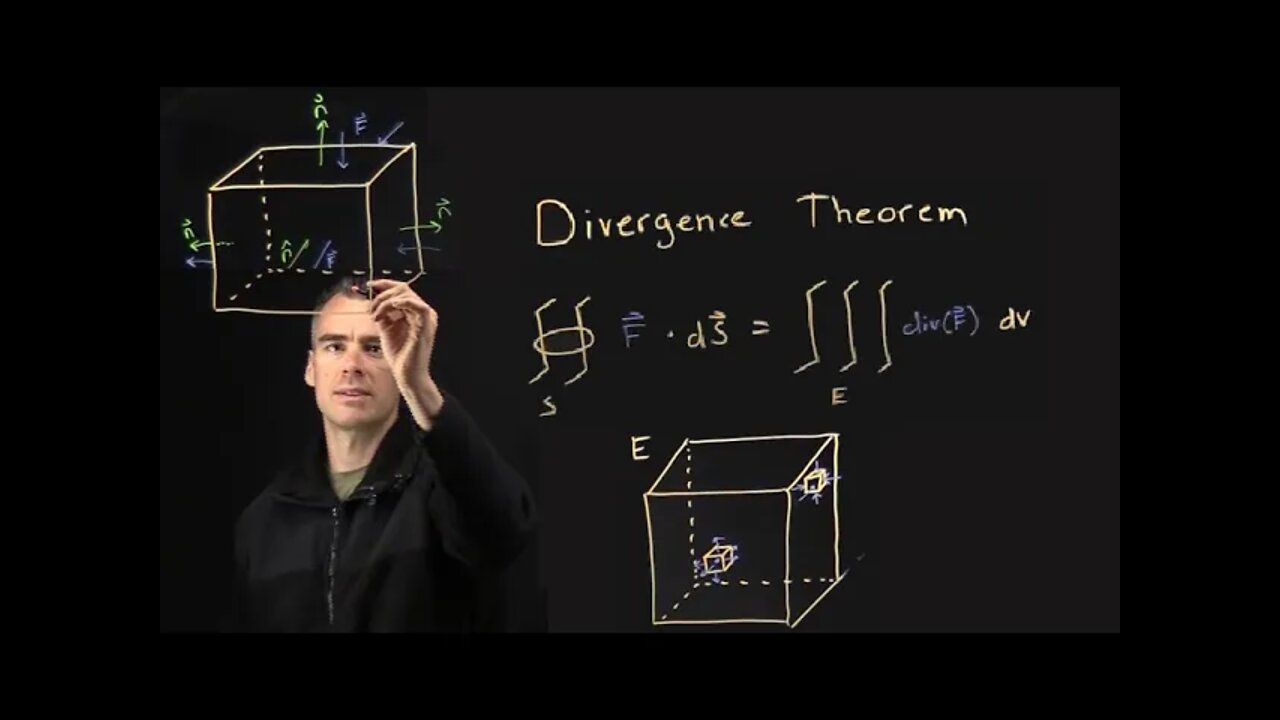Premium Only Content

Intuition behind the Divergence Theorem (why it's true)
Intro:
The Divergence Theorem may not be intuitively obvious just looking at it, but if you consider it, I imagine you’ll find it’s easier to understand intuitively than Green’s or Stokes’ Theorems.
Intuition: basic example
Let’s take a look at the triple integral on the right first and try to get an idea of what this is capturing. This triple integral is basically summing up the divergence of our vector field in all these little cubes inside our region E
Let’s take a simple case where, say, the vector field represents the flow of water.
And say we have a water source in the middle of this region. If that water is coming out from this point, we would say the vector field has a positive divergence there. The divergence is a ‘flux density’. It’s a sort of derivative of the vector Field F, and would be in terms in this case, of say, liters of water per cm^3 emanating from the source region. So if we integrate over the region E, we’d sort of ‘cancel out’ the cm^3 and end up with the Liter’s of water emanating from the region E.
Now let’s look at the left side. This is a surface integral finding the FLUX of this vector field emanating through the the surface S, where we define S as the surface ENCLOSING our region E. Let’s imagine this is a sort of mesh surface the water will flow through. Say our water flow vector field has units of Liters/cm^2, so when we integrate over the surface we again sort of cancel out the ‘cm^2’ and are left with the FLUX, or the the total amount of water, leaving the surface enclosing the region E.
So, hopefully you see, the left and right sides of the equation are both telling you the same thing – the amount of water leaving the region, which is the same thing as saying – the amount of water going through the surface enclosing the region.
Intuition – more examples
Now, say we added a drain within this region that is taking in the water.
If we added these up we’d have a positive divergence source and a negative divergence drain, and if they were of the same magnitude they may cancel out so that the triple integral, or sum of the divergence over the region would be 0
And what would that look like on the surface integral side? Well, the vector field might show all the water from the source going out the drain, so there were no vector fields at the surface, or… it might show that the water was emanating from one side of the surface boundary but water was going in on the other side of the boundary. In either case, if the source and drain were of equal magnitude, we’d see the the flux exiting and entering the sides of the surface boundary would cancel out and you’d get a total flux of 0.
So… hopefully that provides some intution behind the divergence theorem and perhaps, like me, you find it easier to understand than Green’s or Stokes’ Theorem, but it might be worth quickly noting some of the similarities betweeen the theorems.
Similarity to Green’s/Stokes’ Theorem
While Stoke’s Theorem has a closed line integral on the left side, the Divergence theorem has a closed surface integral including on the left side. The closed line or surface is a required criteria for both of the theorems.
The closed integrals also correspond to the vector field F ⃗ in both cases
Difference from Green’s/Stokes’ Theorem
A major difference though is of course on the right side of the equation, Stokes’ Theorem uses the curl of F ⃗ while The Divergence theorem uses the divergence of F ⃗.
Also, the divergence theorem operates on a sort of higher dimension on both sides, so it has a double instead of single integral on the left, and a triple instead of double integral on the right.
Someimes it’s good to compare and contrast theories like this to help better scaffold our understanding of them.
So I hope this helped provide a little bit better intuition on the Divergence Theorem, and until next time, take care!
-
 2:09:24
2:09:24
Inverted World Live
6 hours agoRats Have Learned to Hunt Bats | Ep. 135
28.3K7 -
 2:48:01
2:48:01
TimcastIRL
6 hours agoLIVE Election Coverage: Polling Stations SWATTED, Bomb Threats Called In | Timcast IRL
245K168 -
 3:30:07
3:30:07
Barry Cunningham
7 hours agoBREAKING NEWS: COUNTDOWN TO COMMUNISM! ELECTION RESULTS SHOW!
54.7K41 -
 2:11:28
2:11:28
DeVory Darkins
6 hours agoLIVE NOW: 2025 Election results and Exit Polls AMA
65K42 -
 2:34:04
2:34:04
DLDAfterDark
5 hours ago $0.05 earnedJust Another Tuesday - In Virginia - The Governor's Race & Glock Talk
26K4 -
 3:21:38
3:21:38
The Charlie Kirk Show
8 hours agoJUDGMENT DAY 2025: The Election Results Stream
194K78 -
 3:51:07
3:51:07
MattMorseTV
9 hours ago $0.77 earned🔴Election Day LIVE COVERAGE.🔴
95.8K46 -
 1:16:51
1:16:51
Flyover Conservatives
1 day agoSHOCKING DATA REVEALS: Young Voters Are Done With the Old GOP - Mark Mitchell, Rasmussen Reports | FOC Show
40.5K17 -
 1:15:28
1:15:28
Sarah Westall
8 hours agoGrooming is Protected and Encouraged by the System – Michelle Peterson and Mike Adamovich
34.2K10 -
 4:00:13
4:00:13
Akademiks
6 hours agoKendrick tries to Flip the Bots on DRAKE? WHo Beats Jay z in a verzuz. Blueface finally free!
38.5K9